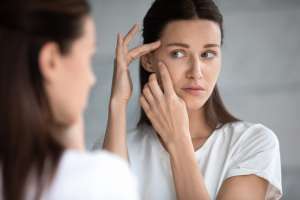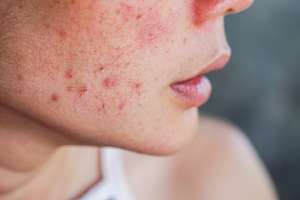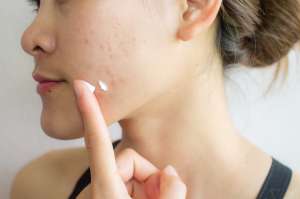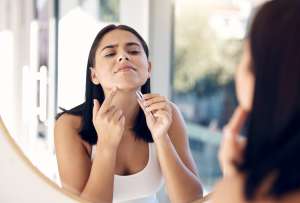Acne, a common skin condition affecting individuals of all ages, often exhibits a pattern linked to hormonal fluctuations, particularly those associated with the menstrual cycle. The link between acne and the menstrual cycle underscores the complex interplay between hormones and skin health. In this article, we look into the mechanisms behind this connection, exploring how hormonal shifts influence acne development and strategies for managing menstrual-related breakouts.

The link between acne and the menstrual cycle underscores the complex interplay between hormones and skin health, influencing acne development and treatment strategies. By addressing hormonal imbalances and adopting targeted skincare and lifestyle practices, individuals can effectively manage menstrual-related breakouts and achieve clearer, healthier skin.
1. Hormonal Dynamics and Acne Development
a. Estrogen and Progesterone Influence
Estrogen and progesterone levels fluctuate throughout the menstrual cycle, impacting various bodily processes, including sebum production and skin cell turnover. While estrogen tends to have a stabilizing effect on the skin, progesterone can stimulate sebaceous gland activity, potentially leading to increased oil production and acne flare-ups.

b. Androgens and Sebum Production
Androgens, a group of hormones including testosterone, play a significant role in acne development by stimulating sebum production. During certain menstrual cycle phases, such as ovulation and the luteal phase, androgen levels peak, resulting in heightened sebum secretion. Excess sebum can clog pores and create an environment ideal to acne formation.
2. Menstrual Cycle Phases and Acne Patterns
a. Pre-Menstrual Acne Flare-Ups
Many individuals experience a worsening of acne symptoms in the days before menstruation, commonly referred to as pre-menstrual acne. This phenomenon is attributed to the rise in progesterone levels during the luteal phase, which promotes sebum production and contributes to pore congestion and inflammation.

b. Hormonal Acne During Ovulation
Some individuals may also notice an increase in acne breakouts during ovulation, coinciding with the peak in androgen levels. Elevated androgen activity stimulates sebaceous glands. This leads to excess oil production and the development of hormonal acne lesions, like cysts and nodules, particularly in individuals prone to this type of acne.
3. Managing Menstrual-Related Acne
a. Topical Treatments and Skincare Regimens
In addition to hormonal interventions, topical treatments and skincare regimens can help manage menstrual-related acne. Ingredients like benzoyl peroxide, salicylic acid, and retinoids target acne-causing bacteria, unclog pores, and promote skin cell turnover, reducing the severity and frequency of breakouts.

b. Hormonal Birth Control
For individuals struggling with hormonal acne linked to the menstrual cycle, hormonal birth control can be an effective treatment option. Oral contraceptives containing estrogen and progestin help regulate hormone levels, reduce sebum production, and reduce acne symptoms by balancing hormonal fluctuations throughout the menstrual cycle.

4. Lifestyle Factors and Acne Management
a. Diet and Acne Triggers
Certain dietary factors, such as high glycemic index foods and dairy products, may trigger acne by influencing hormone levels and inflammation. Adopting a balanced diet rich in fruits, vegetables, whole grains, and lean proteins can support hormonal balance and contribute to clearer skin.
b. Stress and Acne Outbreaks
Chronic stress can worsen acne by triggering hormonal imbalances and inflammatory responses in the body. Implementing stress-reduction techniques such as mindfulness, meditation, and regular exercise can help reduce stress-induced acne flare-ups and promote overall skin health.

The link between acne and the menstrual cycle highlights the significant impact of hormonal fluctuations on skin health. By understanding the underlying mechanisms driving menstrual-related acne and implementing targeted interventions, individuals can effectively manage breakouts and achieve clearer, healthier skin.
